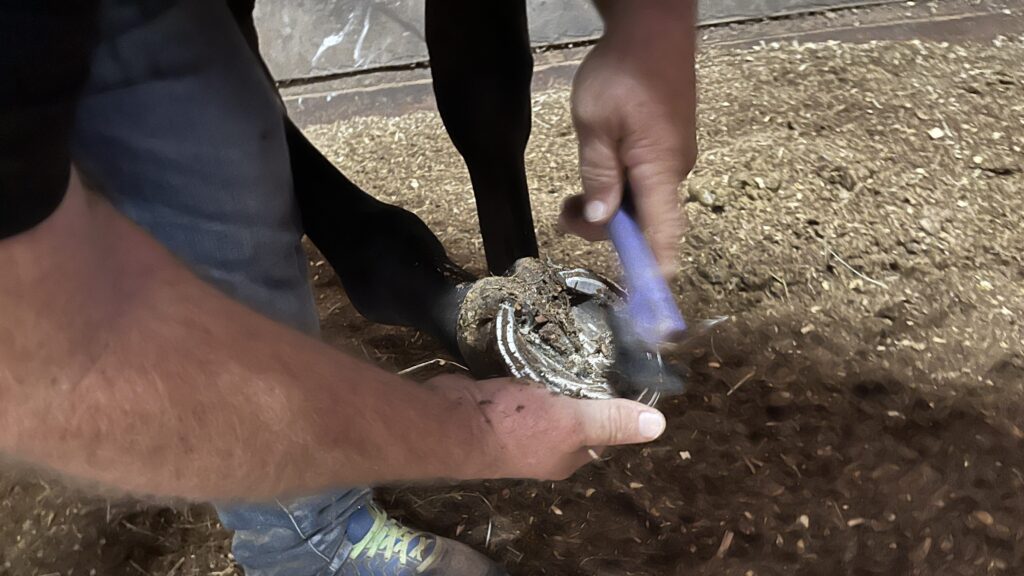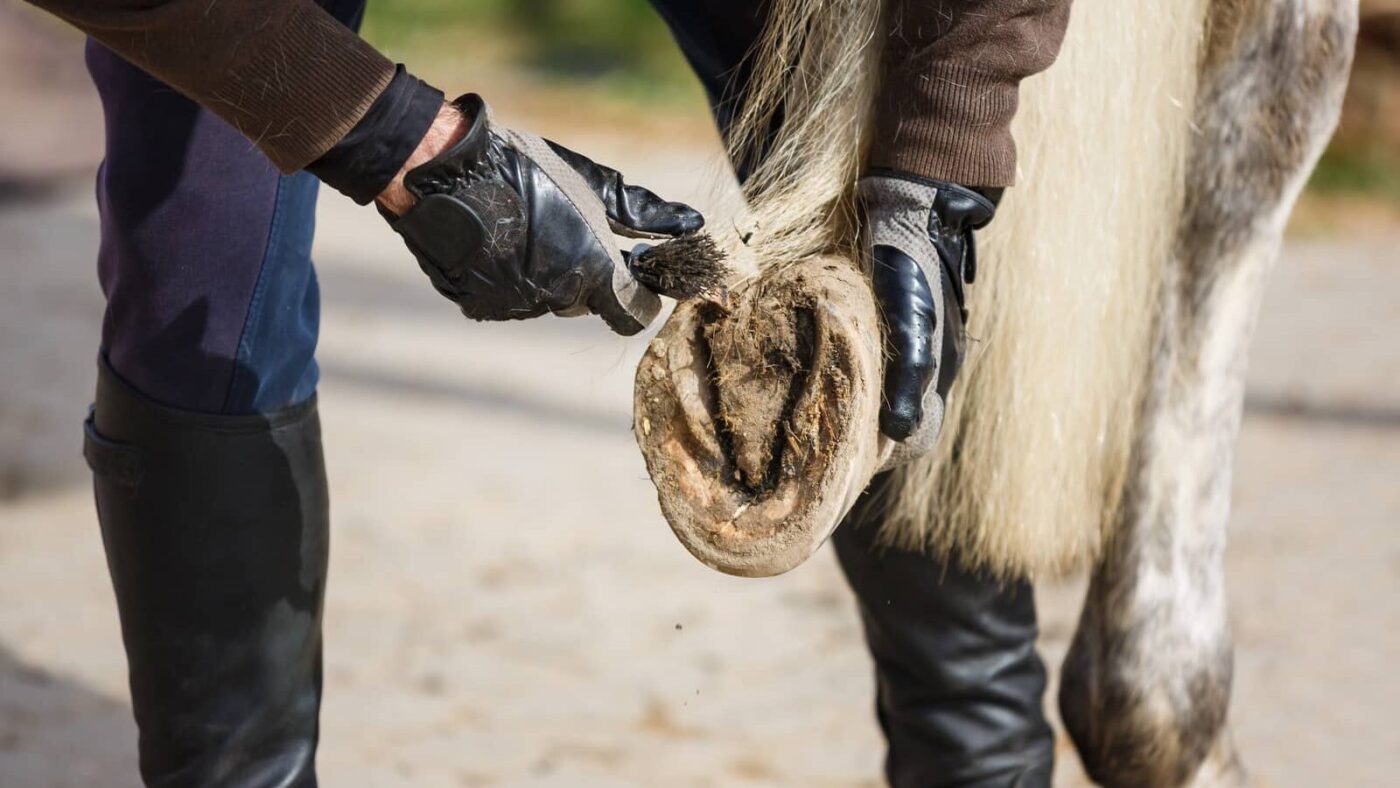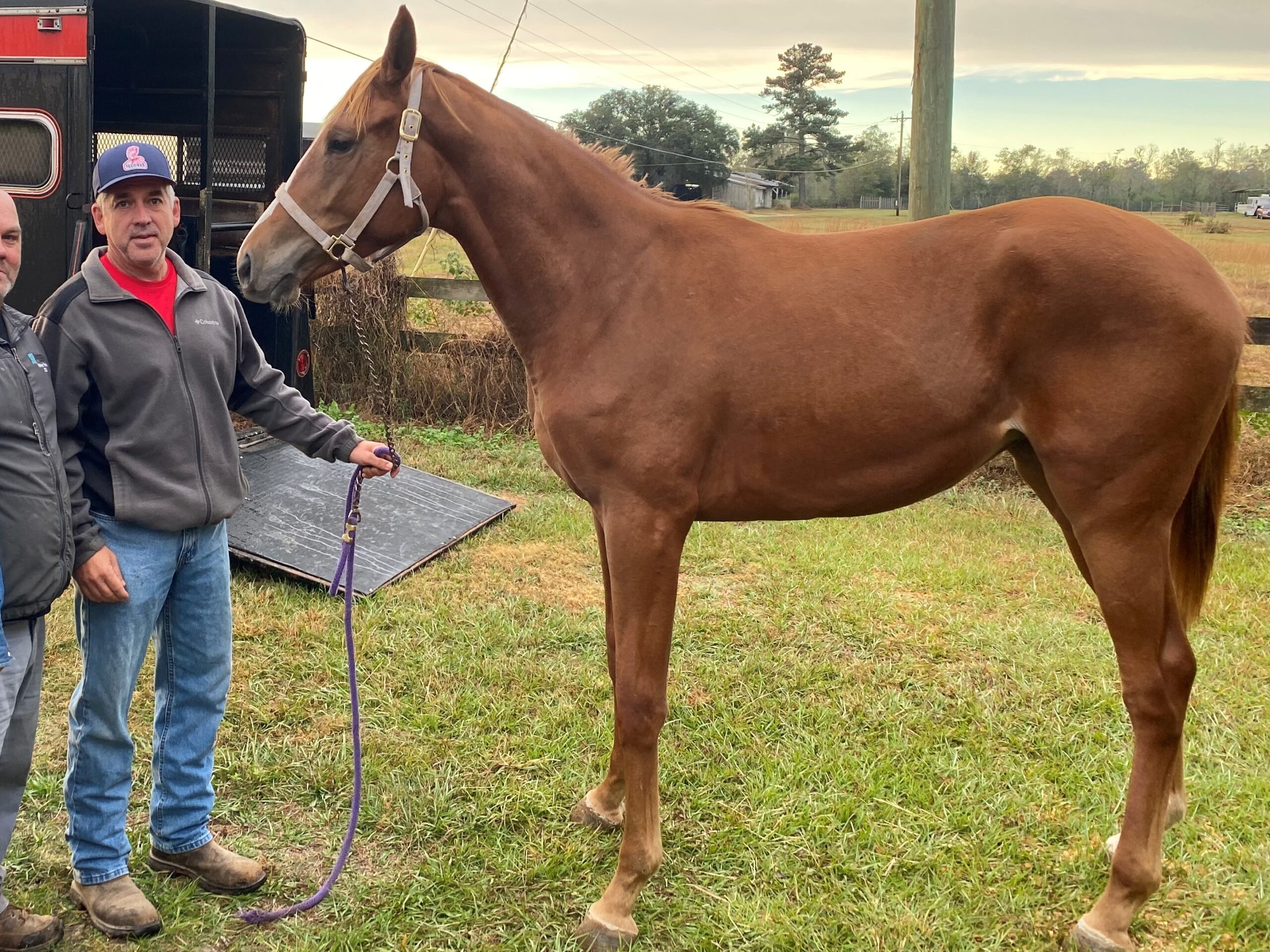Last updated: June 14, 2025
Any links on this page that lead to products on Amazon are affiliate links and I earn a commission if you make a purchase. Thanks in advance – I really appreciate it!
Have you ever struggled to keep your horse’s hooves healthy during challenging weather? Up to 80% of horses face hoof-related issues, making proactive care essential for their well-being.
I’ve been there myself. One rainy season, despite my best efforts, one of my horses developed thrush—a common hoof problem caused by wet conditions. With guidance from my farrier and a diligent care routine, we resolved it, but the experience reinforced just how vital consistent hoof care is for keeping horses sound and healthy.
In this article, you’ll learn practical tips for maintaining healthy hooves, from anatomy basics to addressing common issues like thrush and abscesses. Whether you’re a seasoned owner or just starting, these insights will keep your horse thriving.

Understanding the Anatomy of Horse Hooves
The horse’s hoof is a complex structure composed of several parts, each playing a vital role in the horse’s ability to move and support its weight.
- Hoof Wall: The outer part of the hoof is similar to a human fingernail made of keratin. It protects the inner structures and bears most of the horse’s weight.
- Sole: The bottom part of the hoof provides protection to the inner structures. It’s concave, which helps grip surfaces and cushion the impact.
- Frog: A V-shaped structure located on the underside of the hoof. It helps with shock absorption and provides traction.
- White Line: The junction between the hoof wall and the sole. It’s crucial for maintaining the hoof’s structure and integrity.
- Bars: Extensions of the hoof wall that help support the weight and maintain the hoof’s shape.
- Heel Bulbs: Soft structures at the back of the hoof, aiding in shock absorption.
Now that you understand the structure of a horse’s hoof, it’s easier to see how each part plays a role in keeping your horse sound. But even with the best care, hoof problems can arise. Let’s explore the most common issues and how to address them.
How to Solve Common Horse Hoof Problems
Several common hoof issues can arise if proper care is not maintained. From bacterial infections to structural issues, hoof problems can vary widely in severity. Here’s a closer look at some of the most frequent challenges horse owners face, starting with thrush.
Thrush
Description: Thrush is a bacterial infection that affects the sole, often caused by dirty, wet conditions. Symptoms include a foul odor and black discharge.
How to Address:
- Clean Environment: Keep the horse’s living area clean and dry.
- Regular Cleaning: Clean the hooves daily to remove any debris.
- Topical Treatments: Apply antiseptic solutions or thrush-specific treatments as a veterinarian recommends.
Abscesses
Description: Abscesses are infections within the hoof that can cause severe pain and lameness. They often result from puncture wounds or poor hoof hygiene.

How to Address:
- Veterinary Care: Consult a veterinarian to properly drain and treat the abscess.
- Hoof Soaking: Soak the affected hoof in a warm Epsom salt solution to help draw out the infection.
- Bandaging: Keep the hoof clean and protected with a bandage until it heals.
Recognizing and addressing abscesses quickly is critical. Here’s a personal experience that highlights the importance of prompt action: While cleaning my horses feet during routine grooming, I noticed a foul smell and heat—clear signs of an abscess.
Fortunately, my farrier was at the barn that day shoeing two of my other horses. I asked him to take a look, and he quickly confirmed my suspicion. With a small incision, he drained the abscess and advised me to soak the hoof twice daily in a warm Epsom salt solution to prevent further infection. Thanks to this timely intervention, the horse recovered quickly and was back on his feet in no time.
Laminitis
Description: Laminitis is inflammation of the laminae, often related to diet or metabolic issues. It can cause severe pain and potentially permanent damage to the hoof. The American Association of Equine Practitioners provides valuable resources on managing laminitis, including dietary strategies and anti-inflammatory treatments.
How to Address:
- Diet Management: Ensure a balanced diet and avoid overfeeding grains or lush pastures.
- Medication: Administer anti-inflammatory medications as prescribed by a veterinarian.
- Supportive Care: Provide soft bedding and limit movement to reduce stress on the hooves.
To dive deeper into laminitis prevention and treatment, check out our guide on Understanding Horse Laminitis: Causes, Symptoms, and Treatment.

Hoof Cracks
Description: Hoof cracks can occur in the hoof wall and may result from trauma, poor diet, or inadequate hoof care. Cracks can lead to more serious issues if left untreated. In one case, a hoof crack I caught early prevented a major setback for my horse. Here are some ways to address hoof cracks.
How to Address:
- Regular Trimming: Schedule regular farrier visits to maintain proper hoof shape and prevent overgrowth.
- Hoof Moisturizers: Use a hoof conditioner to prevent dryness and cracking, especially in dry conditions.
- Protective Boots: Use hoof boots to protect the hooves from rough terrain or during exercise.
While understanding and addressing specific problems is crucial, prevention is always the best approach. Regular maintenance can save you time, money, and heartache by keeping your horse’s hooves in top condition.
Essential Hoof Maintenance Tips for Horse Owners
Regular hoof care is vital to prevent problems and ensure the health of your horse’s hooves.
- Daily Hoof Care: Picking and cleaning the hooves daily removes dirt, stones, and manure, preventing thrush and other infections.
- Regular Farrier Visits: Schedule visits with a certified farrier every 6–8 weeks to maintain hoof balance. The American Farrier’s Association offers certifications to ensure top standards.
- Diet and Environment: University of Florida experts stress that balanced nutrition—including protein, vitamins, and minerals—is key for hoof health. Keep stalls clean and dry to reduce bacterial and fungal risks.
- Trimming: According to the Merck Veterinary Manual, “Proper trimming every 4–8 weeks ensures good hoof and leg balance.”
- Monitor for Early Signs: Check for heat, swelling, or cracks to catch issues before they worsen.
Download our Daily Hoof Care Checklist to ensure your routine covers every critical step.
Of course, hoof care routines can vary depending on the time of year. Seasonal changes bring unique challenges that every horse owner should prepare for.
Seasonal Hoof Care: Tips for Different Weather Conditions

Seasonal changes present unique challenges to horse hoof care, necessitating tailored strategies to maintain optimal hoof health. Here’s an expanded guide addressing specific regional concerns and product recommendations:
Wet Conditions (e.g., Pacific Northwest or Rainy Seasons)
Excess moisture can soften hooves, increasing susceptibility to infections like thrush.
Management Strategies:
- Maintain Dry Environments: Ensure stalls are clean and dry, utilizing absorbent bedding to minimize moisture exposure.
- Regular Hoof Cleaning: Daily removal of mud and debris prevents bacterial buildup.
- Apply Hoof Sealants: Products like Horseshoer’s Secret® Deep-Penetrating Hoof Conditioner can help maintain hoof integrity by repelling excess moisture.
Dry Conditions (e.g., Southwestern United States)
Arid climates can lead to brittle, cracking hooves due to lack of moisture.
Management Strategies:
- Use Hoof Moisturizers: Applying conditioners such as Farnam Rainmaker Triple Action Hoof Moisturizer helps retain necessary moisture.
- Controlled Exposure: Limit time on hard, dry surfaces to reduce hoof stress.
- Balanced Nutrition: The University of Minnesota Extension notes that ‘nutrition can help some hoof problems,’ particularly in maintaining flexibility during dry weather. A balanced diet rich in biotin and essential minerals is critical for healthy hoof growth.
Cold and Icy Conditions (e.g., Northern Regions)
Snow and ice can compact in hooves, leading to discomfort and potential injuries.
Management Strategies:
- Regular Hoof Inspection: Daily checks to remove ice buildup and detect issues early.
- Provide Traction: Using hoof boots designed for winter conditions can prevent slips.
- Maintain Activity: Regular movement encourages healthy circulation to the hooves.
While these seasonal care tips provide a solid foundation, it’s important to adapt them based on your horse’s unique needs. Factors like age, activity level, and pre-existing conditions can influence how your horse’s hooves respond to seasonal challenges. Consult with your farrier or veterinarian to tailor these strategies and ensure your horse remains comfortable and sound year-round.
While seasonal care is crucial for adapting to environmental challenges, another important decision in hoof care involves whether to keep your horse barefoot or shod—a choice that impacts hoof health and performance.

Barefoot or Shod? Weighing the Pros and Cons.
Have you ever wondered why wild horses don’t require shoes? Their natural environment and lifestyle play a significant role, as discussed in our article on Why Don’t Wild Horses Need Shoes? But what about domestic horses, can they go barefoot? There are pros and cons to both keeping horses barefoot and using horseshoes:
- Barefoot: Benefits include a more natural hoof function and fewer issues with shoeing problems. However, it requires a strong, healthy hoof and regular maintenance.
- Shod: Shoes provide extra protection and support, especially for horses with weak hooves or those working on hard, abrasive surfaces. Regular shoeing by a skilled farrier is necessary.
- Curious about the impact of horseshoes on hoof health? Learn more in our detailed article Do Horse Shoes Hurt Horses?
Experts at the University of California, Davis School of Veterinary Medicine emphasize the importance of gradual transitions and proper hoof conditioning for horses moving from shoes to barefoot. To toughen the hooves, gradually increase the horse’s exposure to different terrains. If you’re considering keeping your horse barefoot, our guide on Can You Ride a Horse Barefoot? provides practical tips and considerations.
Regardless of whether your horse is barefoot or shod, some situations call for advanced hoof care techniques to address specific challenges and support long-term hoof health.

Advanced Hoof Care Techniques for Special Needs
Advanced hoof care techniques are essential for addressing specific equine health challenges, offering tailored solutions to promote optimal hoof function and overall well-being.
Therapeutic Shoeing
Costs and Benefits:
Therapeutic shoeing involves specialized shoeing methods to correct or manage hoof and limb pathologies.
- Benefits: This approach can alleviate pain, correct deformities, and enhance mobility in horses with conditions such as laminitis or navicular disease. For instance, the heart-bar shoe has been instrumental in supporting the hoof structure in laminitic horses. American Farriers
- Costs: The expense varies based on the complexity of the condition and the materials used. While standard shoeing might cost less, therapeutic shoeing requires specialized skills and materials, leading to higher costs. However, investing in therapeutic shoeing can prevent more severe issues and potential long-term veterinary expenses.
Hoof Supplements
Proper nutrition plays a pivotal role in maintaining hoof health. Specific supplements can address deficiencies and promote stronger hooves.
- Biotin: A B-vitamin essential for keratin production, biotin supplementation has been shown to improve hoof hardness and growth rates.
- Methionine: An amino acid that supports keratin formation, methionine aids in strengthening the hoof wall.
- Zinc and Copper: These trace minerals are vital for proper hoof development and repair.
When to Use: Supplements are beneficial when horses exhibit poor hoof quality, slow growth, or are recovering from conditions like cracks or laminitis. It’s crucial to consult with a veterinarian or equine nutritionist to tailor supplementation to individual needs.
Success Stories
Implementing advanced hoof care techniques has yielded positive outcomes:
- Therapeutic Shoeing: Research published in the Equine Veterinary Journal highlights the effectiveness of therapeutic shoeing in managing conditions like laminitis and navicular disease.
- Hoof Supplements: A therapeutic farrier reported significant improvement in a client’s horse after switching to a comprehensive hoof supplement, leading to restored hoof health and overall vitality. Omega Fields
By incorporating advanced hoof care techniques, such as therapeutic shoeing and targeted supplementation, horse owners can address specific challenges and support long-term hoof health. However, these methods are most effective when paired with consistent routine care, such as daily cleaning, proper trimming, and a balanced diet. Together, these practices create a comprehensive approach to maintaining your horse’s hoof health.
Check out this YouTube video on horse hoof care tips.
Frequently Asked Questions
Here are answers to some of the most frequently asked questions about horse hoof care, from daily maintenance routines to addressing common issues. Whether you’re a seasoned horse owner or just starting, these insights can help you keep your horse’s hooves healthy and strong.
How often should I clean my horse’s hooves?
It’s best to clean your horse’s hooves daily to remove dirt, stones, and manure. This helps prevent infections and allows you to check for any early signs of problems.
What signs indicate my horse might have a hoof problem?
Common signs of hoof problems include lameness, a foul smell from the hoof, visible cracks, swelling, or heat in the hoof. If you notice any of these signs, consult your farrier or veterinarian.
Can my horse go barefoot, or do they need shoes?
Whether a horse can go barefoot depends on various factors, including their hoof health, the type of terrain they work on, and their activity level. Consult with your farrier to determine the best option for your horse.
How often should my horse see a farrier?
Most horses need to see a farrier every 6-8 weeks. However, the exact frequency can vary depending on the horse’s hoof growth rate and any specific hoof care needs.
What can I do to improve my horse’s hoof health?
Ensure your horse has a balanced diet rich in essential vitamins and minerals, provide a clean and dry environment, and maintain a regular hoof care routine. Supplements like biotin can also support hoof health.
How do I transition my horse from shod to barefoot?
Transitioning a horse from shod to barefoot should be done gradually. Increase their exposure to different terrains slowly, and provide hoof boots if necessary to protect their hooves during the transition.

Conclusion
Proper hoof care is the cornerstone of your horse’s overall health and well-being. By proactively addressing challenges like hoof thrush, cracks, or laminitis, you can keep your horse’s hooves strong, healthy, and ready for work. Regular maintenance, a balanced diet, and advanced care techniques like therapeutic shoeing or supplements are key to preventing laminitis and ensuring optimal horse hoof health.
Want to learn more about hoof thrush treatment, preventing laminitis, or other equine care strategies? Sign up to receive weekly hoof care tips, exclusive success stories, and actionable advice straight to your inbox.
We’d also love to hear from you! Share your hoof care experiences and tips in the comments below. Your stories could inspire and guide other horse owners facing similar challenges. Let’s build a community of knowledge to keep our horses sound and thriving together.

About the Author: Miles Henry
Lifelong Horseman | Racehorse Owner | Published Author
Miles Henry brings over 25 years of hands-on experience training and owning Thoroughbred racehorses. Raised with Quarter Horses and Appaloosas, he’s spent a lifetime learning from horses—on the track, in the barn, and in the field. Today, he runs a small but successful racing stable in Louisiana and shares real-world insights on HorseRacingSense.com, helping horse owners, fans, and bettors navigate the sport with confidence.
📚 Books: View Miles’s books on Amazon »
🎧 Podcast Guest: Animal Tales Ep. 32 |
YouTube Interview
📩 Newsletter: Sign up for racing tips and horse care advice »
🔗 Follow Miles:
Twitter |
Facebook |
YouTube


